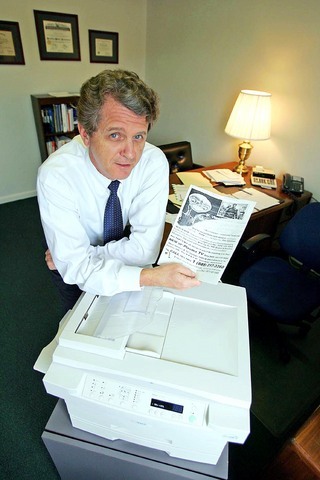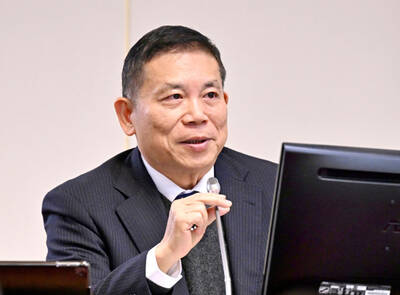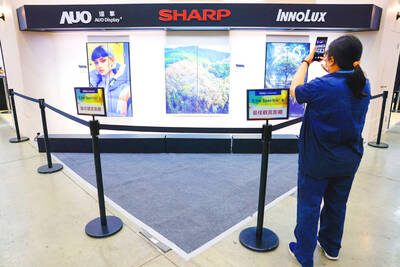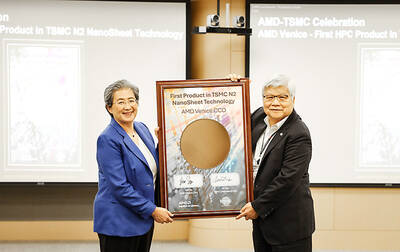If any of Rodney Eddins' accounting clients want his undivided attention at work first thing in the morning, they should shun e-mail or his telephone answering machine. Instead, they should send him a fax.
"The first thing I look at when I arrive is the incoming tray of my fax machine," said Eddins, a certified public accountant in Orlando, Florida, who has had his own practice for a decade. "If there's paper there, I feel like I have to look at it."
Only after he sorts through the morning's faxes -- though most on a recent day were ads like one for a workplace deodorizing service -- does Eddins log on to his computer and listen to his phone messages.

PHOTO: THE NEW YORK TIMES
Still, like many other people, Eddins readily acknowledges a tortured relationship with his fax machine. Finding it essential for transmitting sensitive accounting documents and forms that require signatures, like tax returns, he grudgingly tolerates the noise and mess, not to mention the deluge of junk faxes.
"I actually hate my fax machine," he said. "But I need it."
In an office world that has gone largely digital, hand-held and wireless, the fax machine is ancient technology that just won't go away. No one shows off her fax machine the way she might, say, a BlackBerry. Yet the fax persists as a mockery of the much-predicted paperless society.
"Back in the mid-1990s, when e-mail was really coming into its own, we had high-priced consultants telling us that the fax was going the way of the horse and buggy," said Jonathan Bees, then a product manager for office machines at Konica; he is now editor in chief of Better Buys for Business magazine. Among the products he reviews for consumers these days are fax machines. "They're better than ever -- quieter, faster and with clearer reproduction," he said. "They haven't been passed by, after all."
Some 1.5 million fax machines were sold in the US last year for use at both businesses and homes, according to the Consumer Electronics Association, based in Arlington, Virginia. Manufacturers estimate that they sold 500,000 more machines that combined a fax function with other functions, like copying and scanning.
Although sales of stand-alone fax machines are well below their peak of 3.6 million in 1997, some manufacturers say that if the multi-use machines are included, demand has been rising of late.
"We have been seeing an increase in fax sales for the last four or five years," said Paul Fountain, marketing product manager at Hewlett-Packard in San Diego.
In 1994, Hewlett-Packard left the fax market, believing the predictions of impending obsolescence. But, Fountain said, "We came back in 1998 because we realized the fax was not going away."
While fax machines are not as prevalent as computers in the workplace or home offices, Bill Young, a communications coach at the Strickland Group in New York City, said, "The fax has important functions that e-mail simply hasn't been able to take over."
Those would include reproducing signatures on documents like contracts, business proposals and medical prescriptions.
Another factor in the fax's favor is security.
"With a fax, you don't have to worry about computer hackers or someone stealing the password to the recipient's e-mail," Young said. "As long as there's a person at the receiving fax ready to remove the paper, the message is confidential." (Some computers have the capacity to convert the image of an incoming fax to e-mail, but that method loses the privacy advantage.)
Falling prices have helped to maintain the fax's popularity.
"The fax machine you would buy at Costco or Staples 10 years ago for the home office would typically cost about US$200," Fountain said. "Better machines are available today for US$45."
The US$200 machine a decade ago would have been a stand-alone fax. Now, Hewlett offers the Fax 1050 -- a combination fax, copier and answering machine -- for US$99.
But faxes priced at US$100 and less can have at least one drawback: they typically transmit and print at a rate of only about four pages a minute. More money buys more speed, among other things. One business model from Sharp is the FO DC525, which costs US$3,000 and transmits and prints 20 pages a minute.
Commercial machines are available for mass faxing of more than 100 pages a minute. But the prices of such machines can reach US$70,000, and they are usually more the size of mainframe computers than office machines, so you won't find them in the fax aisle at Staples.
All of this has come too late to benefit the fax's inventor, the Scottish physicist Alexander Bain. He patented the first primitive fax machine in 1843, some 30 years before the telephone. Called the "recording telegraph," Bain's invention used a stylus attached to a pendulum, which passed over metal type to sense light or dark spots on the plated "document" being sent. A pendulum on the receiving device made a stain on chemically treated paper when electric charges were sent on a telegraph line. But Bain's innovation came nearly 100 years before the Information Age, and there was little demand for it. He died poor.
Bain might have been mortified at one problem with today's fax machines: their vulnerability to their own version of junk mail. Junk faxers can tie up machines and delay important messages, and some critics label them thieves.
"They can steal a lot of paper from recipients who don't even want to get their ads," said Lawrence Markey, a lawyer at the Foundation for Taxpayer and Consumer Rights in Santa Monica, California.
He started suing junk faxers in 2001, in California small-claims courts. Such litigation is painstaking, he said.
"I have collected about US$5,000 so far from various companies," he said, "not nearly enough to compensate for my time."
One plus, though, he said, is that junk faxers don't seem to be dialing his number as often.

Taiwan will prioritize the development of silicon photonics by taking advantage of its strength in the semiconductor industry to build another shield to protect the local economy, National Development Council (NDC) Minister Paul Liu (劉鏡清) said yesterday. Speaking at a meeting of the legislature’s Economics Committee, Liu said Taiwan already has the artificial intelligence (AI) industry as a shield, after the semiconductor industry, to safeguard the country, and is looking at new unique fields to build more economic shields. While Taiwan will further strengthen its existing shields, over the longer term, the country is determined to focus on such potential segments as

UNCERTAINTY: Innolux activated a stringent supply chain management mechanism, as it did during the COVID-19 pandemic, to ensure optimal inventory levels for customers Flat-panel display makers AUO Corp (友達) and Innolux Corp (群創) yesterday said that about 12 to 20 percent of their display business is at risk of potential US tariffs and that they would relocate production or shipment destinations to mitigate the levies’ effects. US tariffs would have a direct impact of US$200 million on AUO’s revenue, company chairman Paul Peng (彭雙浪) told reporters on the sidelines of the Touch Taiwan trade show in Taipei yesterday. That would make up about 12 percent of the company’s overall revenue. To cope with the tariff uncertainty, AUO plans to allocate its production to manufacturing facilities in

COLLABORATION: Given Taiwan’s key position in global supply chains, the US firm is discussing strategies with local partners and clients to deal with global uncertainties Advanced Micro Devices Inc (AMD) yesterday said it is meeting with local ecosystem partners, including Taiwan Semiconductor Manufacturing Co (TSMC, 台積電), to discuss strategies, including long-term manufacturing, to navigate uncertainties such as US tariffs, as Taiwan occupies an important position in global supply chains. AMD chief executive officer Lisa Su (蘇姿丰) told reporters that Taiwan is an important part of the chip designer’s ecosystem and she is discussing with partners and customers in Taiwan to forge strong collaborations on different areas during this critical period. AMD has just become the first artificial-intelligence (AI) server chip customer of TSMC to utilize its advanced

Chizuko Kimura has become the first female sushi chef in the world to win a Michelin star, fulfilling a promise she made to her dying husband to continue his legacy. The 54-year-old Japanese chef regained the Michelin star her late husband, Shunei Kimura, won three years ago for their Sushi Shunei restaurant in Paris. For Shunei Kimura, the star was a dream come true. However, the joy was short-lived. He died from cancer just three months later in June 2022. He was 65. The following year, the restaurant in the heart of Montmartre lost its star rating. Chizuko Kimura insisted that the new star is still down